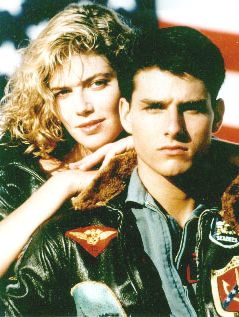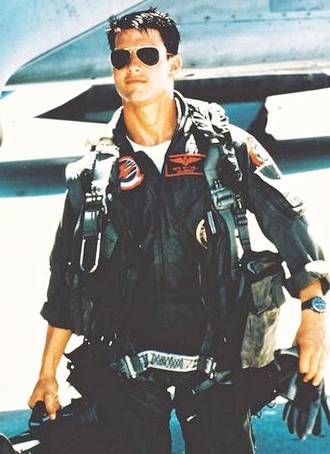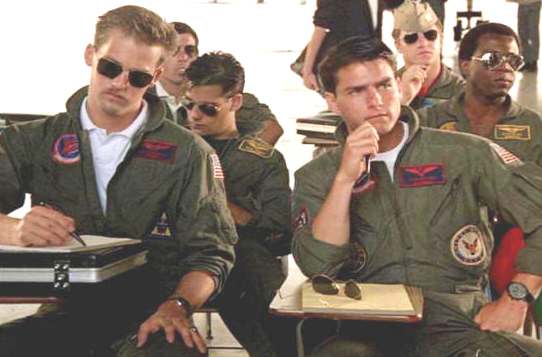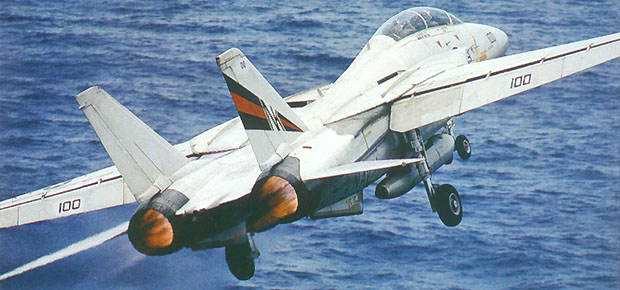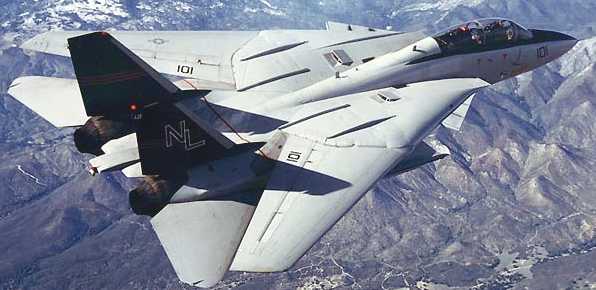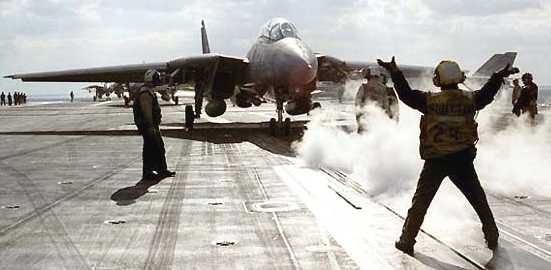|
TOP GUN - 1986
|
|||||||||||||||||||||||||||||||||||||||
|
Maverick is a hot pilot. When he encounters a pair of MiGs over the Persian Gulf, his wingman is clearly out-flown and freaks. On almost no fuel, Maverick is able to talk him back down to the Carrier. When his wingman turns in his wings, Maverick is moved up in the standings and sent to the Top Gun Naval Flying School. There he fights the attitudes of the other pilots and an old story of his father's death in combat that killed others due to his father's error. Maverick struggles to be the best pilot, stepping on the toes of his other students and in a different way to Charlie, a civilian instructor to whom he is strongly attracted.
Kelly McGillis and Tom Cruise as 'Maverick'
Directed
by Tony Scott
Genre: Action
/ Drama
/ Romance
Tom Cruise as 'Maverick'
Also Known As:
When
see Jerry
Bruckenheimer amongst the producers, you know within a
millisecond what you will be getting. He produces movies
for the mass audience, which are more indicative of the
perception of coolness within the era the movie is
produced. ‘Top Gun' is a prime example of this. It is
Eighties personified. The only thing missing is the big
hair. We were saved this due to the fact that the movie is
set within the Air Force.
Kelly McGillis
Meg Ryan
Anthony Edwards as 'Goose' and Tom Cruise as 'Maverick'
F-14 TOMCAT - STANDARD FLEET FIGHTER AIRCRAFT, USA
The F-14 Tomcat is the US Navy's carrier-based two-seat air defence, intercept, strike and reconnaissance aircraft. The aircraft was developed by Northrop Grumman to replace the F-4 Phantom fighter and entered service with the US Navy in 1972. In 1987, the F-14B – with an upgraded engine – went into production. Further upgrades in the radar, avionics and missile capability resulted in the F-14D Super Tomcat which first flew in 1988. The US Navy operated 338 F-14 aircraft of all three variants, but the aircraft is being replaced by the F/A-18E/F Super Hornet. F-14 squadrons have started to change to the new aircraft, a process which will continue until the aircraft is finally retired from service in 2007.
The variable sweep wing and the twin almost upright tail fins of the F-14 Tomcat give the aircraft its distinctive appearance. The variable sweep wings are set at 20° for take-off, loitering and landing and automatically change to a maximum sweep of 68°, which reduces drag for high subsonic to supersonic speeds. The wings are swept at 75° for aircraft carrier stowage.
COCKPIT
Catseye night-vision goggles have been installed in the F-14 since 1996 and are supplied by BAE SYSTEMS. The F-14D front cockpit is equipped with a head-up display and two multi-function flat-screen displays. The rear cockpit for the Radar Intercept Officer is equipped with a display which presents fused data from the AN/APG-71 radar and from the suite of aircraft sensors.
82 US Navy F-14B's are being upgraded with Flight Visions, Inc, Sparrow Hawk HUD and FV-3000 Modular Mission Display System, which will improve reliability and night vision capability. The cockpit is equipped with the NACES zero/zero ejection seat supplied by Martin Baker Aircraft Company.
WEAPONS
The F-14 is armed with a General Electric Vulcan M61A-1 20mm gun with 675 rounds of ammunition, which is mounted internally in the forward section of the fuselage on the port side.
The aircraft has eight hardpoints for carrying ordnance, four on the fuselage, and two each side under the fixed section of the wings. The aircraft can carry the short-, medium- and long-range air-to-air missiles AIM-9, AIM-7 and AIM-54, and air-to-ground ordnance including the Rockeye bomb and CBU cluster bombs. Raytheon AIM-7 Sparrow is a medium-range radar-guided air-to-air missile with range of 45km. Lockheed Martin/Raytheon AIM-9 Sidewinder is a short-range air-to-air missile with range of 8km. Raytheon AIM-54 Phoenix is a long-range air-to-air missile with range of 150km. The F-14 can carry up to six Phoenix missiles and is capable of firing the missiles almost simultaneously at six different targets. The F-14D can carry four Joint Direct Attack Munitions (JDAM). First operational deployment of a precision-guided JDAM from an F-14 was in March 2003.
In 1995, the US Navy installed the Lockheed Martin LANTIRN precision strike navigation and targeting pod on the F-14. The LANTIRN targeting pod includes a dual field of view FLIR and a laser designator/rangefinder. The navigation pod also contains a FLIR and terrain-following radar. A Lockheed Martin infrared search and track system is installed in a sensor pod under the nose.
SENSORS
The F-14D is equipped with a Raytheon AN/APG-71 digital multi-mode radar, which provides non-cooperative target identification, and incorporates low sidelobe techniques and enhanced frequency agility.
The F-14 carries a Tactical Air Reconnaissance Pod System (TARPS), which carries a Recon/Optical KS-87B forward or vertical frame camera, a low-altitude panoramic view KA-99 camera together with a Lockheed Martin AN/AAD-5 infrared linescanner. The pod is equipped with a digital imaging system for the transmission of near real-time imagery to the aircraft carrier command centre via a secure UHF radio data link. To supplement TARPS, US Navy F-14's are also being fitted with a Fast Tactical Imagery (FTI) system, which is a line-of-sight system for targeting and reconnaissance.
COUNTERMEASURES
The aircraft is equipped with the BAE Systems Integrated Defense Solutions (formerly Tracor) and Lockheed Martin AN/ALE-39 and AN/ALE-29 chaff, flare and decoy dispensers. The Super Tomcat has a Raytheon AN/ALR-67(V)4 radar warning system and BAE Systems Information & Electronic Warfare Systems (IEWS) (formerly Sanders) AN/ALQ-126 jammer.
ENGINE
The F-14B and the F-14D have two General Electric F110-GE-400 turbofan engines rated at 72kN and 120kN with afterburn. There are five internal fuel tanks which carry 9,000l and are located in the fixed section and the outer section of the wings and in the rear section of the fuselage between the engines.
A - Z FILMS INDEX
A - Z ACTORS INDEX
Solarnavigator is designed to carry the Scorpion anti pirate weapon. A fleet of such autonomous vessels could be the basis of an international peacekeeping, and/or emergency rescue force, the same platform is also ideal for endurance high-speed oceanographic surveys. This same vessel is also the star of the John Storm adventure series, the first of which is: The $Billion Dollar Whale
|
|||||||||||||||||||||||||||||||||||||||
|
This website is copyright © 1991- 2013 Electrick Publications. All rights reserved. The bird logo and names Solar Navigator and Blueplanet Ecostar are trademarks ™. The Blueplanet vehicle configuration is registered ®. All other trademarks hereby acknowledged and please note that this project should not be confused with the Australian: 'World Solar Challenge'™which is a superb road vehicle endurance race from Darwin to Adelaide. Max Energy Limited is an educational charity working hard to promote world peace. |
|||||||||||||||||||||||||||||||||||||||
|
AUTOMOTIVE | BLUEPLANET BE3 | ELECTRIC CARS | ELECTRIC CYCLES | SOLAR CARS | SOLARNAVIGATOR |
|||||||||||||||||||||||||||||||||||||||
